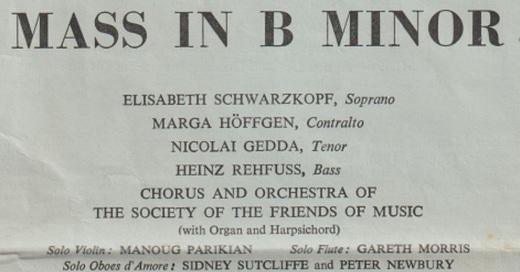Bach's B minor Mass - reflections and recordings
There is probably no piece of music that has been subjected to greater research and diversity of performance styles than J.S.Bach’s Mass. Many books have been written on the complex genesis of the work, and there may well be hundreds, if not thousands of research papers. The diversity of performance styles is matched by the range of recordings. The Bach Cantata web site lists over 300 recordings and there is a very useful entry on Wikipedia which attempts to categorise the features that are the points of difference between the recordings. My go-to reference book on the Mass is authored by George Stauffer.
As I was researching this post I discovered the notes written by Walter Emery for the recording by Karajan made in Vienna in 1952, then in London in 1953 and released in 1954. (The history of that recording is quite a story – but for another day!)
Until recently my only CD was the 1985 recording by John Elliot Gardiner with the Monteverdi Choir. Gardiner devotes Chapter 13 to the Mass in his book Music in the Castle of Heaven and his views on the piece are well worth reading. The Mass is an example of where the BWV number (232) makes it look like an early work whereas in reality it was Bach’s final gift to the world.
Over the last few decades my own views of Bach and the performance of his music have been informed by many books and recordings, though I have so much more to learn. Seeing the play The Score recently brought home to me the situation that Bach found himself in towards the end of his life. Most of the music of the Mass originates from earlier compositions. This is often referred to as ‘parody’, a term I dislike as it now tends to be used as a derogatory description.
Although there is a substantial amount of discussion about the use that Bach made of his compositions there is never a thought about the depth of his memory, not just for the individual pieces but for perhaps just a few bars or a section of a cantata. Remember that by the time he started work on the Mass his vision was already fast deteriorating, and he may well not have had physical access to all his scores. I can think of no other composer that has made such extensive use of their own music and created a work that defies critical analysis.
A few weeks ago, I heard an except from a new recording of the Mass by Raphaël Pichon conducting his Ensemble Pygmalion. It certainly caught my attention and my credit card! I have now listened to the entire Mass probably a half dozen times, each time finding intriguing approaches but also a few elements that I found less to my liking. There are some cadential rests that seem to last a little too long, and the flow feels lost momentarily lost. One of the performance challenges is to decide on the scale of the vocalists and orchestra, remembering Joshua Rifkin’s amazing one-voice-to-a part recording in 1983. Here there are around 30 vocalists and roughly the same number of instrumentalists. The recording balances chorus and orchestra very well indeed.
There is of course a strong interest on the use of Historically Informed Performance approaches, but Pichon takes a rather individualistic perspective, especially on dynamics. The transition from the Kyrie to the Gloria will take your breath away. A feature of the recording is the way in which the bass line is quite prominent throughout but is shaped with considerable care. It is a pity that the booklet does not note whether it was played with a Violone or a double bass.
The ‘Crucifixus’ is an adaptation of Cantata 12, Weinen, Klagen, Sorgen, Zagen which Bach had composed as early as 1714 (that memory again!). In the Mass it is presented in E minor over an incessant descending chromatic bass. The penultimate bar uses an augmented sixth chord to reach G major in anticipation of the ‘Et resurrexit’ that follows. Pichon’s singers manage to achieve a long ppp final chord whilst maintaining perfect pitch. The dynamic is not in the score but it works to perfection.
Many of the sections are taken at quite a pace but always with a strong pulse and immaculate singing and playing. There is a very interesting analysis of the speeds taken by recording made up to the early 2000s in a thesis by Uri Golomb but for some reason I can read it on screen but not download it onto my PC. The variations of speed on disk are very wide indeed!
There will never be a definitive recording of the Mass as we have so little information about the final years of Bach’s life and what he was seeking to achieve. There are no contemporary documents relating to it, or letters. We will never know what lay behind Bach’s decision to expend so much effort on assembling the music and ordering it with such care in preparation for a performance he probably knew he would not experience first-hand. To go back to Gardiner’s book, surely the Mass is a major contribution to the music in the castle of heaven.




